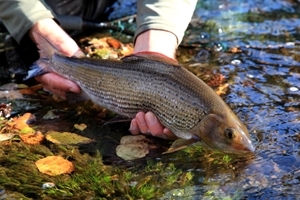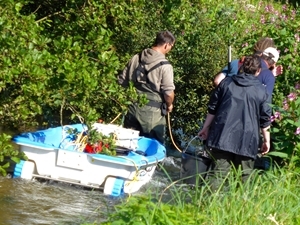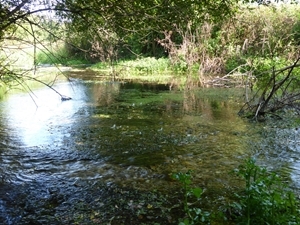Key points
- European grayling are important for fisheries across Europe. However, some populations have declined in recent years.
- This study aimed to understand how river flow and temperature can affect how well they survive from eggs to young fish.
- Every autumn between 2009 and 2016, young grayling were sampled at six sites in a southern English chalk stream. Local river flow rates and water temperatures were recorded year-round.
- This study suggested that river flow and temperature were both important for young grayling survival. More days of low river flow during spring and summer were related to lower survival.
- This study also suggested that the ideal water temperature for young grayling survival is 13.5°C. Temperatures higher than 13.5°C reduce survival.
- To improve survival for young grayling, river management should aim to reduce extreme flows, so that the river is more stable. Fewer days of low river flow in summer as well as steady water temperatures may help grayling populations.
Background
 European grayling. Photo courtesy of Rod Calbrade.
European grayling. Photo courtesy of Rod Calbrade.European grayling numbers have been falling in recent years, and only a few studies have investigated this. Most research has focused on species like salmon and trout, which are in the same family as grayling (the salmonids). While grayling share some characteristics with these other salmonids, there are also important differences. European grayling do not migrate out to sea like Atlantic salmon and sea trout. Instead, they generally migrate within rivers. This means that young grayling don’t move far from the location where they hatched. In Great Britain, grayling are found in only a small number of rivers, including the Hampshire Avon and River Wylye.
Grayling reproduce later in the year than other salmonids, usually in spring when water temperatures are warmer. They lay their eggs shallower in the gravel of the riverbed, and their eggs are generally less able to cope with extreme water temperatures. These factors make grayling a good species to study to investigate the effects of unusual temperatures and water flows on salmonid breeding.
Grayling breeding success varies from year to year, and the number of young fish produced can be affected by many factors. As grayling lay their eggs in rivers, egg survival to the young stage can be influenced by the density of young fish present, river flow rate and water temperature.
The impact of river flow and temperature on young grayling can vary, depending on the time of year. For example, high river flows during the spawning period can be positive. A fast flow will wash fine sediment out of the riverbed and prevent the eggs from being smothered. On the other hand, after spawning and when the eggs are developing, fast flow can be negative because eggs and newly emerged fish larvae could be washed out of the riverbed. The number of young fish living in the river can also affect their chances of survival. If there are large numbers of young fish (of the same species or a similar species), there will be more competition between them all for the same resources. Weaker individuals will be less likely to survive.
It is important to understand the possible effect of river flow and temperature on the survival of young grayling as both these environmental factors are likely to be influenced by climate change.
What they did
 This study took place in the River Wylye, a chalk stream in southern England. Chalk streams are usually fed by groundwater as opposed to rainwater, which means they have a relatively stable flow of water and water temperature. Despite having a relatively stable flow overall, high flow events have become more frequent on the River Wylye since the early 1990s. Low flow conditions are then more likely to occur between these high flow events.
This study took place in the River Wylye, a chalk stream in southern England. Chalk streams are usually fed by groundwater as opposed to rainwater, which means they have a relatively stable flow of water and water temperature. Despite having a relatively stable flow overall, high flow events have become more frequent on the River Wylye since the early 1990s. Low flow conditions are then more likely to occur between these high flow events.
Every October between 2009 and 2016, the scientists sampled grayling and trout at six sites along the River Wylye. Fish were captured using electro-fishing, and were then measured, weighed and aged. When the sampling was finished, fish were put back in the river in the same place that they were captured. The scientists used this data to estimate the number of young grayling at each site in the River Wylye and in each year of the study.
The scientists also estimated the number of eggs produced each year. To do this, they counted and weighed the adult grayling. Previous research has found a relationship between the weight of an adult female grayling and the number of eggs produced. The scientists then used these estimates to calculate the survival from eggs to young grayling.
Long-term records of river flow were obtained from the National River Discharge Archive. Water temperature was recorded throughout the study period. From these data, the scientists calculated the following environmental variables:
- Number of days with high flow during the incubation period
- Unseasonal temperatures during the incubation period
- Number of days with low river flow during the post-incubation period
- Unseasonal temperatures during the post-incubation period
The incubation period is in spring and relates to the survival of eggs. The post-incubation period is in summer and relates to the survival of young fish. The total number of young trout was also estimated for each year from the data collected during fish sampling.
The scientists then looked at which environmental factors had the biggest effect on young grayling survival.
What they found
The highest numbers of grayling were caught in 2009, 2010, 2014 and 2015, when some sites contained more than 100 fish. The lowest numbers of grayling were caught in 2012 and 2013, when most sites contained fewer than 25 individuals.
The statistical model showed that young grayling survival was related to four environmental factors:
- Temperature during incubation period – As water temperature increased, survival of young grayling increased.
- Temperature during post-incubation period – After the incubation period, as water temperature increased up to 13.5°C, young grayling survival also increased. In water temperatures over 13.5°C, young grayling survival decreased.
- Low river flow during post-incubation period – When there were more days with low river flow during the summer, young grayling survival decreased.
- Young trout densities – As the density of young trout increased, young grayling survival increased.
What does this mean?
 Extreme and unseasonal changes to the river flow and water temperature affected the number of young grayling. This highlights that climate change is a potential threat for grayling populations.
Extreme and unseasonal changes to the river flow and water temperature affected the number of young grayling. This highlights that climate change is a potential threat for grayling populations.
This study found that warmer water during the incubation period was better for grayling survival. A different study on salmon found similar results and explained that, when eggs hatched in warmer water, they were bigger and survived better than the eggs that hatched in colder water.
The ideal post-incubation temperature for young grayling was 13.5°C, which is the same as the average temperature of the River Wylye. This suggests that local grayling populations might have adapted to these specific river conditions, but means that any future temperature increases could be particularly bad for young grayling. To reduce the risk of this happening, bankside vegetation can be maintained to provide shade over the water.
Another result from this study that supports other studies on salmonids was that low river flow in the summer reduces young survival. Low river flow in the summer is thought to reduce the amount of food that flows downstream. To tackle this problem, more stable river flows can be restored, for example by controlling the removal of groundwater for agriculture.
The final result from this study was unexpected. Higher densities of young trout were linked to better grayling survival. The scientists had assumed that the two species would be competing for the same food and habitat, but the result actually suggests that the two species use slightly different habitats and do not need to compete.
Overall, this results of this study emphasise the importance of good river management. Management to restore more stable river flows and limit temperature increases would benefit grayling. Other salmonid species will also benefit from this management, making their populations more resilient to future changes.
Note: In this summary, we have used the phrase “river flow” to describe the amount of water passing a specific point per second. This refers to the combination of both the volume of water and the speed at which the river is flowing and is defined as “river discharge”.
Read the original abstract
Bašić,T., Britton, J.R., Cove, R.J., Ibbotson, A.T., & Gregory, S.D. (2018). Roles of discharge and temperature in recruitment of a cold-water fish, the European grayling Thymallus thymallus, near its southern range limit. Ecology of Freshwater Fish, 27: 940-951.